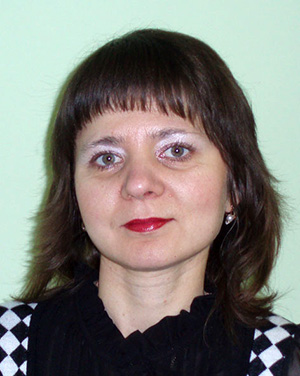|
 UDC 332:003.13:330.11.4; JEL E22, O18, O40
UDC 332:003.13:330.11.4; JEL E22, O18, O40
Shults, S. L., & Lutskiv, O. M. (2022). Prostorovi ta sektoral'ni determinanty produktyvnoyi spromozhnosti rehioniv: teoretychna heneza ta metodolohichni zasady doslidzhennya [Spatial and sectoral determinants of regional productive capacity: theoretical genesis and methodological principles of the study]. Rehional'na ekonomika - Regional Economy, 106 (4), 5-20. DOI: https://doi.org/10.36818/1562-0905-2022-4-1 [in Ukrainian].
Sources: 49
Authors
Shults Svitlana LeonidivnaDoctor of Economics, Professor
Head of the Department of regional economic policy of the Dolishniy Institute of Regional Research of NAS of Ukraine
Contacts:  swetshul@i.ua, swetshul@i.ua,  (032)270-70-89, (032)270-70-89,  (+38097)253-66-22 (+38097)253-66-22
Webpages:           

Lutskiv Olena MykolayivnaPh.D. of Economics, Senior Researcher
Senior Researcher, Scientific Secretary of the unit of the Department of regional economic policy of the Dolishniy Institute of Regional Research of NAS of Ukraine
Contacts:  lutolen@i.ua, lutolen@i.ua,  (032)270-7089 (032)270-7089
Webpages:      
ResumeIn the pre-war period, the stagnation of economic productivity was observed in Ukraine. It was manifested by a decrease in the annual growth rates of labor and capital productivity. The natural consequences of this include the inability to increase the growth rate of employees’ wages and their purchasing power, the increase in the share of raw material exports in the total volume, the country's growing dependence on energy imports, etc. The lack of positive productivity dynamics is related to the lack of active encouragement of domestic enterprises to improve resource efficiency. The article aims to substantiate the theoretical and methodological foundations of the study of the productive capacity of the regional economy in Ukraine and determine its potential growth accelerators across spatial and sectoral determinants. The evolution of the theoretical basis of the concept of economic productivity at the national and regional levels is examined. Based on the interpretation of the concepts of “productivity” and “capacity”, the authors offer their definition of the meaning of the term “regional productive capacity”. The article characterizes the achievements of foreign researchers regarding the study of regional development features and problems of productivity; identification and assessment of the impact of spatial factors on the productivity of the economy of territorial systems of different hierarchical levels; identification of spatial determinants of regional productive capacity. Based on the analysis of the experience of empirical research on assessing the impact of spatial factors on economic productivity, the article outlines a number of its growth patterns. The specific nature of interregional and intraregional productivity disparities is presented. The article proves that the interaction of spatial and sectoral determinants determines the level of productivity of the national, regional, and individual territorial communities’ economies. Special attention is paid to the issue of resource productivity. Ways for further theoretical and practical studies of regional productive capacity are suggested.
Keywords:productivity, regional productive capacity, factors of production, spatial determinants, resource productivity
References- Semykina, M. V. (2010). Produktivnist’ pratsi: metodolohiya vimiryuvannya, peredumovy zrostannya [Labor productivity: measurement methodology, prerequisites for growth]. In Naukovi pratsi Kirovohrads’koho natsional’noho tekhnichnoho universytetu. Ekonomichni nauki. Scientific works of the Kirovohrad National Technical University. Economic sciences]: Vol. 17, 457-463. [in Ukrainian].
- Bondar, I. K. (1991). Proizvoditel’nost’ truda: voprosy teorii i praktiki [Labor productivity: questions of theory and practice]. K.: Scientific opinion. [in Russian].
- Petyukh, V. M. (1995). Rynochnaya ekonomika: nastol’naya kniga delovogo cheloveka [Market economy: a handbook for a business person]. K.: Harvest. [in Russian].
- Prokopenko, I. I. (1990). Upravleniye proizvoditel’nost’yu [Performance management]: Practice guide. K.: Technics. [in Russian].
- Yeremenko, V. O. (2000). Pidvishhennya produktyvnosti: teoriya, svitovyy dosvid, shlyah Ukrayiny [Increasing productivity: theory, world experience, Ukraine’s way]. Kramatorsk: Publishing House of the Productivity Center of the Ministry of Labor and Social Policy of Ukraine. [in Ukrainian].
- Sukharskyy, V. S. (2002). Menedzhment: teoriya, metodolohiya, praktyka [Management: theory, methodology, practice]. Ternopil: Aston. [in Ukrainian].
- Dmytryshyn, B. V. (2010). Doslidzhennya produktyvnosti suchasnykh ekonomichnykh system na osnovi modeley mizhhaluzevoho balansu [Study of the productivity of modern economic systems based on intersectoral balance models]. In Naukovi pratsi Kirovohrads’koho natsional’noho tekhnichnoho universytetu. Ekonomichni nauki [Scientific works of the Kirovohrad National Technical University. Economic sciences]: Vol. 18:ІІ, 85-92.[in Ukrainian].
- Mohilat, I., Horshkova, N., & Kozhemyakina, S. (2009). Produktyvnist’ pratsi, produktyvnist’ kapitalu ta sukupna faktorna produktyvnist’: dynamika i faktory vplyvu na nykh [Labor productivity, capital productivity and total factor productivity: dynamics and factors influencing them]. Ekonomika Ukrayiny – Economy of Ukraine, 8, 4-16. [in Ukrainian].
- Sink, D. S. (1989). Upravleniye proizvoditel’nost’yu: planirovaniye, izmereniye i otsenka, kontrol’ i povysheniye [Performance management: planning, measuring and evaluating, monitoring and improving]. M.: Progress. [in Russian].
- Larina, O. H. (2013). Mizhnarodna konkurentospromozhnist’ rehioniv [International competitiveness of regions in global conditions of development]. (Ph.D. in Econ. Thesis, SHSS «Kyiv national economy university named after V. Hetman»). Kyiv. [in Ukrainian].
- Mazurkevych, I. O., Bondar, I. K., & Solohub O. P. (2006). Matrytsya produktyvnoyi ekonomiki [Matrix of productive economy]. PH «Corporation». [in Ukrainian].
- Solohub O. P. (1998). Produktyvnist’ ekonomiki: rehional’ni aspekty [Productivity of the economy: regional aspects]. K.: Knowledge. [in Ukrainian].
- Bilodid, I. K. (Ed.). Slovnyk ukrayins’koyi movy [Dictionary of the Ukrainian language]: 11 vols. Vol. 9. (1980). Institute of Linguistics of the Academy of Sciences of the Ukrainian SSR the editorship. K.: Scientific opinion. [in Ukrainian].
- Dubichynskyy, V. V. (Ed.) (2006). Suchasnyy tlumachnyy slovnyk ukrayins’koyi movy [Modern explanatory dictionary of the Ukrainian language]. Kharkiv: PH «School». [in Ukrainian].
- Filipenko, A. S. (2017). Produktyvna spromozhnist’ natsiyi: sotsial’no-ekonomichnyy vymir [Productive capacity of the nation: socio-economic dimension]. In Productive capacity of nations: the example of Ukraine [Productive capacity of nations: the example of Ukraine]: Proceedings of the International Scientific Conference, June 29, 2017, Kyiv (pp. 13-14). [in Ukrainian].
- Smith, A. (2001). Dobrobut natsiyi. Doslidzhennya pro pryrodu ta prychyny dobrobutu natsiyi [The welfare of nations. An inquiry into the nature and causes of the welfare of nations]. Kyiv. [in Ukrainian].
- Keynes, J. M. (1978). Obshchaya teoriya zanyatosti, protsenta i deneg [The general theory of employment, interest and money]. Moscow. [in Russian].
- Turgot, A. R. (1961). Izbrannyye ekonomicheskiye proizvedeniya [Selected economic works]. Moscow: Sotsekgiz. [in Russian].
- Thünen, I. (1926). Izolirovannoye gosudarstvo [An isolated state]. M.: Economic life. in Russian].
- Maltus, T. R. (2007). Opyt o zakone narodonaseleniya [An Essay on the Principle of Population]. Moscow: Direct-Media. [in Russian].
- Clark, J. B. (1992). Raspredeleniye bogatstva [The distribution of wealth]. M.: Economy. [in Russian].
- Solow, R. M. (1957). Technical Change and the Aggregate Production Function. The Review of Economics and Statistics, 39(3), 312-320. DOI: https://doi.org/10.2307/1926047
- Tang, J., & Wang, W. (2004). Sources of Aggregate Labour Productivity Growth in Canada and the United States. The Canadian Journal of Economics, 37(2), 421-444. DOI: https://doi.org/10.1111/j.0008-4085.2004.00009.x
- Alston, L. J., Mueller, B., Melo, M. A., & Pereira, C. (2010). The political economy of productivity in Brazil. IDB Working Paper Series, 104. Retrieved from https://hdl.handle.net/11319/1123
- Oyinloye, M. (2019). Measuring Economic Growth and Productivity: Foundations, KLEMS Production Models, and Extensions. Academia: Website. Retrieved from https://www.academia.edu/66911575/Measuring_Economic_Growth_and_Productivity_Foundations_KLEMS_Production_Models_and_Extensions
- Coyle, D. (2019, Oct 11). This is how productivity is defined in an economy. World Economic Forum: Website. Retrieved from https://www.weforum.org/agenda/2019/10/this-is-how-productivity-is-defined-in-an-economy/?DAG=3&gclid=Cj0KCQiA1NebBhDDARIsAANiDD3hXCpBJSSepbY6aFLFmGGlCtAY5XbXpyANV1HyrawIQzSui0_empkaAtoHEALw_wcB
- Porter, M. (2005). Konkurentsiya [Competition]. M.: Williams. [in Russian].
- Martin, R., &. Sunley, P. (2011). Conceptualizing Cluster Evolution: Beyond the Life Cycle Model? Regional Studies, 45(10), 1299-1318. DOI: https://doi.org/10.1080/00343404.2011.622263
- Cainelli, G., Ganau, R., & Iacobucci, D. (2016). Do Geographic Concentration and Vertically Related Variety Foster Firm Productivity? Micro-Evidence from Italy. Growth and Chang, 47(2), 197-217. DOI: https://doi.org/10.1111/grow.12112
- de Brito, S., & Leitao, J. (2020). Spatial and Sectoral Determinants of Productivity: An Empirical Approach Using an Entropy. Lens. Entropy, 22(11). DOI: https://doi.org/10.3390/e22111271
- Geppert, K., Gornig, M., & Stephan, A. (2003). Regional productivity differences in the European Union. Theoretical predictions and empirical evidence. Retrieved from https://www-sre.wu.ac.at/ersa/ersaconfs/ersa03/cdrom/papers/171.pdf
- Spatial productivity differences within and across regions (2018). In OECD Regions and Cities at a Glance. Paris: OECD Publishing. DOI: https://doi.org/10.1080/00343404.2011.622263
- Marshall, A. (1993). Printsipy ekonomicheskoy nauki [Principles of Economics]: 3 Vols. Vol. 2. M.: Progress. [in Russian].
- Goodman, E., Bamford, J., & Saynor, P. (Eds.) (1989). Small Firms and Industrial Districts in Italy. London: Routledge. DOI: https://doi.org/10.4324/9781315544830
- Aiginger, K., & Rossi-Hansberg, E. (2006). Specialization and Concentration: A Note on Theory and Evidence. Empirica, 33, 255-266. DOI: https://doi.org/10.1007/s10663-006-9023-y
- Brykova, I. V. (2006). Kontsepsiya mizhnarodnoyi konkurentospromozhnosti natsional’noho rehionu ta yiyi praktychnyy vymir [The concept of international competitiveness of the national region and its practical dimension]. Mizhnarodna ekonomichna politika – International economic policy, 4, 29-53. [in Ukrainian].
- Krugman, P. (1991). Increasing Returns and Economic Geography. Journal of Political Economy, 99(3), 483-499. DOI: https://doi.org/10.1086/261763
- Walter, K., Biehler, H., Holst, G., & Schwarz-Kocher, M. (2015). Kennziffer «Produktivität». Bedeutung und Anwendungsmöglichkeiten am Beispiel der Metall-und Elektroindustrie in Ostdeutschland. Frankfurt am Main. DOI: https://doi.org/10.1515/9783110504408-013. Retrieved from https://docplayer.org/38287369-Kennziffer-produktivitaet-bedeutung-und-anwendungsmoeglichkeiten-am-beispiel-der-metall-und-elektroindustrie-in-ostdeutschland.html [in German].
- Moomaw, R. L. (1983). Spatial Productivity Variations in Manufacturing: A Critical Survey of Cross-Sectional Analyses. International Regional Science Review, 8(1), 1-22. DOI: https://doi.org/10.1177/0160017683008001
- The Roadmap to a Resource Efficient Europe (2022). European Comission: Website. Retrieved from http://ec.europa.eu/environment/resource_efficiency/about/roadmap/index_en.htm
- Produktyvnist’ resursiv u Yevropeys’komu Soyuzi u 2017 rotsi [Productivity of resources in the European Union in 2017] (2018, Sep 12). Economic discussion club: Website. Retrieved from http://edclub.com.ua/analityka/produktyvnist-resursiv-u-yevropeyskomu-soyuzi-u-2017-roci [in Ukrainian].
- Tsili staloho rozvytku [Goals of sustainable development] (2022). Global Compact Network Ukraine: Website. Retrieved from https://globalcompact.org.ua/pro-nas/tsili-stijkogo-rozvytku [in Ukrainian].
- Resource productivity statistics (2022). Eurostat: Website. Retrieved from https://ec.europa.eu/eurostat/statistics-explained/index.php?title=Resource_productivity_statistics
- Tsvetkova, A., Terzidis, N., Jong, D., & Knutsso, P. (2020). The spatial dimension of productivity Connecting the dots across industries, firms and places. OECD Regional Development Working Papers, 1. DOI: https://dx.doi.org/10.1787/ba5edb47-en
- Jong, D., Tsvetkova, A., Lembcke, A., & Ahrend, R. A. (2021). Comprehensive approach to understanding urban productivity effects of local governments. Local autonomy, government quality and fragmentation. OECD Regional Development Working Papers, 11. DOI: https://doi.org/10.1787/5ebd25d3-en
- Vermeulen, W. (2022). Policies for resilient local economies. OECD Local Economic and Employment Development (LEED) Papers, 9. DOI: https://dx.doi.org/10.1787/872d431b-en
- Boddy, M., Hudson, J., Plumridge, A., & Webber, D. (2006). Regional Productivity Differentials: Explaining the Gap. ResearchGate: Website. DOI: https://doi.org/10.1111/j.1435-5957.2008.00209.x. Retrieved from https://www.researchgate.net/publication/23697592
- Diewert, E. (2000). The Challenge of Total Factor Productivity Measurement. International Productivity Monitor, 1, 45-52. Retrieved from http://www.csls.ca/ipm/1/diewert-e.pdf
- Productive Capacities Index (2018). UNCTAD: Website. DOI: https://doi.org/10.18356/9789210054355c013. Retrieved from https://unctad.org/topic/least-developed-countries/productive-capacities-index
|